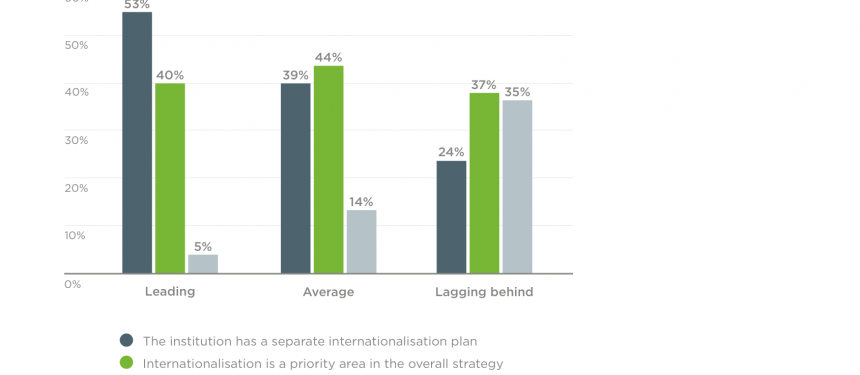Improving the quality of education offered is the primary driver behind efforts to internationalise in Europe, according to the just-released EAIE Barometer, which maps the current state of and challenges around internationalisation of European higher education.
News and business analysis for Professionals in International Education
Have some pie!
Quality is primary driver of international ed: EAIE
 Extract from infographic depicting strategies by levels of internationalisation. Source: EAIE
Extract from infographic depicting strategies by levels of internationalisation. Source: EAIE The EAIE barometer: Internationalisation in Europe details the extent of cross-border collaboration and recruitment in European higher education; it saw 2,411 responses from 33 European countries. Practitioners from higher education institutions made up 87% of the total responses.
Out of the HEI respondents, 56% detailed the quality of education as one of their main reasons to internationalise.
Anna-Malin Sandström, policy officer at EAIE, spoke with The PIE News. “I think this has a lot to do with the EU programmes themselves and many internationalisation activities on national and institutional levels really talk about enhancing quality of education,” she said.
“I think that is sort of an acknowledged reason why institutions in general internationalise,” she added. “It’s nice to [consider] that perhaps the official view is also reflected in the practitioners practical viewpoint of it.”
The second most selected reason for internationalisation was preparing students for a global world (45%), followed by attracting more international students (37%).
Improving strategic partnerships are also one of the biggest challenges that 40% of respondents said they face
Markus Laitinen, vice president of EAIE, noted that students are very much the focus of internationalisation.
“I would group the three first priorities of most important reasons together,” he told The PIE News. “And based on that, my take on it is that it is still very much dominated by international student related issues, both for degree seeking and exchange students.”
The barometer is aiming to provide a roadmap for stakeholders embedded in internationalisation and a gauge of activity. “From the point of view of the actors directly involved in international higher education, there has been no comprehensive research to effectively map the state of internationalisation in the European higher education area (EHEA),” states EAIE.
“One of things is that we didn’t survey internationalisation from an institutional perspective but rather from an individual perspective,” explained Sandström. “So it’s more from the perspective of the practitioners who really work on internationalisation rather than the sort of official institutional view.”
She added: “Internationalisation is a fast evolving field and many of the practitioners really struggle as they don’t really have that much data knowledge about the development about internationalisation in Europe.”
The study also found that 55% have perceived an increase in the number of strategic partnerships, with 20% highlighting a substantial increase.
But improving strategic partnerships is also one of the biggest challenges that 40% of respondents said they face in the internationalisation of HEIs.
“I think this is the sort of, what we call a “new kid on the block”,” said Laitinen. “Strategic partnerships are rather new.”
He added that what might be considered a strategic partnership for one institution, such as “average MoUs or student exchange agreements”, might not be the same for others.
Increasing outward student mobility was also a main challenge for 37% of respondents, with the challenge of implementing the institutional internationalisation strategy a central concern for 35%.
Despite taking over a year to put together, Sandström said the barometer may be a recurring study.
“We want to compare trends over time, to see what changes are happening in the field,” she said. “So we are definitely planning on doing this at a later point in time.”
Still looking? Find by category:




9 Responses to Quality is primary driver of international ed: EAIE